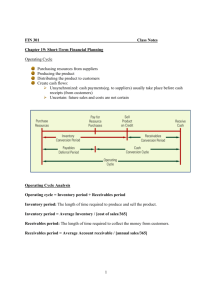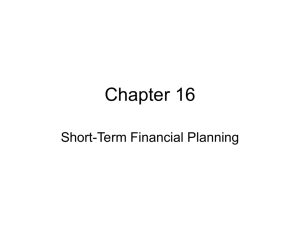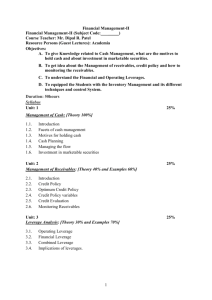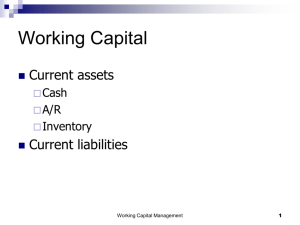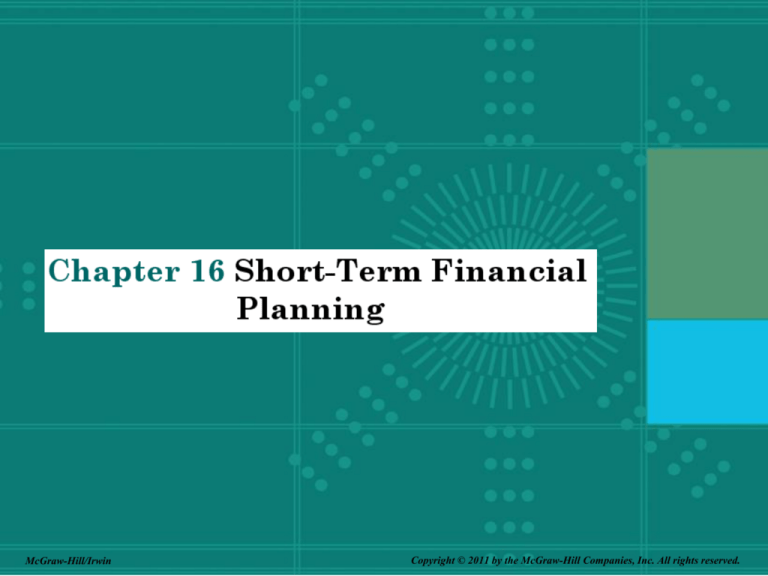
16-1
McGraw-Hill/Irwin
Copyright © 2011 by the McGraw-Hill Companies, Inc. All rights reserved.
Key Concepts and Skills
Understand:
– The operating and cash cycles and
understand why they are important
– The different types of short-term
financial policy
– The essentials of short-term financial
planning
16-2
Chapter Outline
16.1 Tracing Cash and Net Working Capital
16.2 The Operating Cycle and the Cash Cycle
16.3 Some Aspects of Short-Term Financial
Policy
16.4 The Cash Budget
16.5 Short-Term Borrowing
16.6 A Short-Term Financial Plan
16-3
NWC Review
(16.1)
NWC + Fixed assets = L/T Debt + Equity
(16.2)
NWC = (Cash + Other current assets)
– Current Liabilities
(16.3)
Cash = L/T Debt + Equity + Current
Liabilities – Current Assets other
than cash – Fixed assets
16-4
Sources and Uses of Cash
Sources of Cash
– Increase long-term
debt
– Increase equity
– Increase current
liabilities
– Decrease current
assets
– Decrease fixed assets
Uses of Cash
– Decrease long-term
debt
– Decrease equity
– Decrease current
liabilities
– Increase current assets
– Increase fixed assets
16-5
The Operating Cycle
• Time required to receive inventory, sell
it, and collect on the receivables
generated from the sale of the
inventory
• Operating cycle = inventory period +
accounts receivable period
– Inventory period = time inventory sits on the
shelf
– Accounts receivable period = time it takes to
collect on receivables
16-6
Operating Cycle Equations
• Operating cycle = Inventory period +
Accounts receivable period
• Inventory period = 365/Inventory turnover
– Inventory turnover = COGS1/Average Inventory
• Accounts receivable period =
365/Receivables turnover
– = Average Collection Period
– Accounts receivable turnover = Credit
sales/Average accounts receivable
1COGS
= Cost of Goods Sold
16-7
The Cash Cycle
• The time between payment for inventory
and receipt from the sale of inventory
• Cash cycle = operating cycle – accounts
payable period
– Accounts payable period = time between
receipt of inventory and payment for it
• The cash cycle measures how long we
need to finance inventory and
receivables
16-8
Cash Cycle Equations
• Cash cycle = Operating Cycle – Accounts
payable period
• Accounts payable period = 365/Payables
turnover
• Payables turnover = COGS1/Average
account payable
1COGS = Cost of Goods Sold
16-9
The Operating & Cash Cycles
16-10
Corporate Management & S/T
Financial Planning
Table 16.1
16-11
Example Data
Item
Inventory
Accounts Receivable
Accounts Payable
Net Sales
Cost of Goods Sold
Beginning
$2,000,000
$1,600,000
$750,000
$11,500,000
$8,200,000
Ending
$3,000,000
$2,000,000
$1,000,000
Average
$2,500,000
$1,800,000
$875,000
Operating Cycle = Inventory Period + Accounts Receivables Period
Inventory Period = 365/Inventory Turnover
Accounts Receivables Period = 365/Receivables Turnover
= Average Collection Period
Cash Cycle = Operating Cycle – Accounts Payable Period
Accounts Payable Period = 365/Payables Turnover
16-12
Example: Operating Cycle
• Inventory period
– Average inventory = (200,000+300,000)/2 = 250,000
– Inventory turnover = 820,000 / 250,000 = 3.28 x
– Inventory period = 365 / 3.28 = 111 days
• Receivables period
– Average receivables = (160,000+200,000)/2 =
180,000
– Receivables turnover = 1,150,000 / 180,000 = 6.39 x
– Receivables period = 365 / 6.39 = 57 days
• Operating cycle = 111 + 57 = 168 days
16-13
Example: Cash Cycle
• Accounts Payable Period = 365 /
payables turnover
– Payables turnover = COGS / Average AP
• PT = 820,000 / 87,500 = 9.4 x
– Accounts payables period = 365 / 9.4 = 39 days
• Cash cycle = 168 – 39 = 129 days
Inventory and receivables must be
financed for 129 days
16-14
Short-Term Financial Policy
Flexible Policy
– Large amounts of cash
and marketable
securities
– Large amounts of
inventory
– Liberal credit policies
(large accounts
receivable)
– Relatively low levels of
short-term liabilities
High liquidity
Restrictive Policy
– Low cash and
marketable security
balances
– Low inventory levels
– Little or no credit sales
(low accounts
receivable)
– Relatively high levels of
short-term liabilities
Low liquidity
Return to
Quick Quiz
16-15
Flexible Financial Policy
Advantages
• No difficulty
meeting short-term
obligations
• Cash available for
emergencies
• Lower storage
costs
Disadvantages
• Liquid securities =
lower return
• Financing S/T
assets with L/T
debt risky
16-16
Restrictive Financial Policy
Advantages
Disadvantages
• Higher returns on
• Less liquidity for
long term assets
emergencies
• Lower carrying
• Higher storage
costs
costs
• S/T liabilities can
be decreased more
easily in case of
economic downturn
16-17
Carrying versus Shortage Costs
• Carrying costs
– Opportunity cost of owning current assets
versus long-term assets that pay higher returns
– Cost of storing larger amounts of inventory
• Shortage costs
– Order costs – the cost of ordering additional
inventory or transferring cash
– Stock-out costs – the cost of lost sales due to
lack of inventory, including lost customers
16-18
Temporary vs. Permanent Assets
• Permanent current assets
– The level of current assets the company
retains regardless of any seasonality in
sales
• Temporary current assets
– Additional current assets added when
sales are expected to increase on a
seasonal basis
16-19
Alternative Asset
Financing Policies
Figure 16.4
Flexible
Restrictive
16-20
Choosing the Best Policy
• Consider:
– Cash reserves
– Maturity hedging
– Relative interest rates
• Compromise policy = borrow short-term to
meet peak needs, and maintain a cash
reserve for emergencies
Return to
Quick Quiz
16-21
A Compromise Financing Policy
Figure 16.5
16-22
Cash Budget
• Primary tool in short-run financial
planning
– Identify short-term needs and opportunities
– Identify when short-term financing may be
required
• How it works
– Identify sales and cash collections
– Identify various cash outflows
– Subtract outflows from inflows and determine
investing and financing needs
Return to
Quick Quiz
16-23
Cash Budget Example
Fun Toys
• Expected sales by quarter (millions)
Q1: $200; Q2: $300; Q3: $250; Q4: $400
•
•
•
•
•
•
Beginning accounts receivable = $120
Collections = Beginning receivables + ½ x Sales
Accounts payable = 60% of sales
Wages, taxes, and other expenses = 20% of sales
Interest and dividends = $20 million per quarter
Major expansion planned for quarter 2 costing $100
million
• Beginning cash balance = $20 million with minimum
cash balance of $10 million
16-24
Fun Toys
Cash Collections & Cash Disbursements
Cash Collections
Beginning Receivables
Sales (m)
Cash collections
Ending Receivables
Q1
$120
200
220
100
Q2
$100
300
250
150
Q3
$150
250
275
125
Q4
$125
400
325
200
Cash Disbursements
Payment of Accounts (60% of sales)
Wages, taxes, other expenses
Capital expenditures
Long-term financing expenses
(Interest and dividends)
Total Cash Disbursements
Q1
$120
40
0
Q2
$180
60
100
Q3
$150
50
0
Q4
$240
80
0
20
$180
20
$360
20
$220
20
$340
16-25
Fun Toys
Net Cash Flow and Cash Balance
Net Cash Flow
Toal Cash Collections
Total Cash Disbursements
Net Cash Flow
Cash Balance
Beginning Cash Balance
Net Cash Flow
Ending Cash Balance
Minimum Cash Balance
Cumulative Surplus (deficit)
Q1
$220
180
$40
Q2
$250
360
($110)
Q3
$275
220
$55
Q4
$325
340
($15)
Q1
$20
40
$60
(10)
$50
Q2
$60
(110)
($50)
(10)
($60)
Q3
($50)
55
$5
(10)
($5)
Q4
$5
(15)
($10)
(10)
($20)
Comments on Fun Toys Cash Budget:
•Beginning in Q2, Fun Toys will have a cash deficit which must be
covered
•Sales are forecasts and could be much better or worse
16-26
Short-Term Borrowing
Unsecured Loans
• Line of credit
– Prearranged agreement with a bank that
allows the firm to borrow up to a certain
amount on a short-term basis
– May require a “Cleanup period”
• Committed
– Formal legal arrangement that may
require a commitment fee and generally
has a floating interest rate
16-27
Short-Term Borrowing
Unsecured Loans
• Non-committed
– Informal agreement with a bank that is
similar to credit card debt for individuals
• Revolving credit
– Non-committed agreement with a
longer time between evaluations
16-28
Short-Term Borrowing
Secured Loans
• Accounts Receivable Financing
– Assigning receivables
• Lender has A/R as security but borrower
still responsible for collection
– Factoring receivables
• A/R discounted and sold to a factor
• Collection = factor’s problem
16-29
Short-Term Borrowing
Secured Loans
• Inventory Loans
– Blanket inventory lien
• Lender has lien against all inventories
– Trust receipt
• Borrower holds specific inventory in “trust”
for the lender
• Auto dealer “floor plans”
– Field warehouse financing
• Public warehouse acts as control agent to
supervise inventory for lender
16-30
Fun Toys
Short-Term Financial Plan
S/T Financial Plan
Beginning Cash Balance
Net Cash Flow
Net short term borrowing
Interest on S/T borrowing
S/T Borrowing repaid
Ending Cash Balance
Minimum Cash Balance
Cumulative Surplus (deficit)
Beginning Short-term borrowing
Change in short-term borrowing
Ending short-term borrowing
Q1
$20
40
0
0
0
$60
(10)
$50
0
0
$0
Q2
$60
(110)
60
0
0
$10
(10)
$0
0
60
$60
Q3
$10
55
0
(3)
(52)
$10
(10)
$0
60
(52)
$8
Q4
$10
(15)
15.4
(0.4)
0
$10
(10)
$0
8
15.4
$23.4
•Deficit covered with S/T borrowing at 20% APR calculated quarterly
16-31
Quick Quiz - 1
1. What are the differences between
flexible and restrictive short-term
financial policies? (Slide 16.15)
2. What factors do we need to consider
when choosing a financial policy?
(Slide 16.21)
3. What factors go into determining a
cash budget and why is it valuable?
(Slide 16.23)
16-32
Quick Quiz - 2
4. Suppose your average inventory is
$10,000, your average receivables
balance is $9,000, and your average
payables balance is $4,000. Net sales
are $100,000 and cost of goods sold is
$50,000.
What are the operating cycle and cash
cycle?
16-33
Quick Quiz – Problem 4 Solution
Inventory turnover
= 50,000 / 10,000 = 5 x
Inventory period
= 365 / 5 = 73 days
Receivables turnover
= 100,000 / 9,000 = 11.11x
Average collection period = 365 / 11.11 = 33 days
Payables turnover
= 50,000 / 4,000 = 12.5 x
Payables period
= 365 / 12.5 = 29 days
Operating Cycle
Cash Cycle
= 73 + 33 = 106 days
= 106 days – 29 days
= 77 days
16-34
Chapter 16
END



